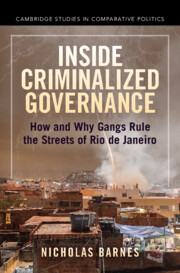Book contents
- Inside Criminalized Governance
- Cambridge Studies in Comparative Politics
- Inside Criminalized Governance
- Copyright page
- Dedication
- Contents
- Figures
- Tables
- Acknowledgments
- A Note on Translation
- Abbreviations, Acronyms, and Translated Words
- 1 Introduction
- 2 Criminalized Governance
- 3 A Theory of Criminalized Governance
- 4 The Origins of Criminalized Governance
- 5 Comando Vermelho of Nova Holanda
- 6 Comando Vermelho of Parque União
- 7 Terceiro Comando (Puro) of Complexo da Maré
- 8 Criminalized Governance during Military Occupation
- 9 Conclusion
- 10 Epilogue
- Appendices
- References
- Index
- Other Books in the Series (continued from page ii)
3 - A Theory of Criminalized Governance
Published online by Cambridge University Press: 06 February 2025
- Inside Criminalized Governance
- Cambridge Studies in Comparative Politics
- Inside Criminalized Governance
- Copyright page
- Dedication
- Contents
- Figures
- Tables
- Acknowledgments
- A Note on Translation
- Abbreviations, Acronyms, and Translated Words
- 1 Introduction
- 2 Criminalized Governance
- 3 A Theory of Criminalized Governance
- 4 The Origins of Criminalized Governance
- 5 Comando Vermelho of Nova Holanda
- 6 Comando Vermelho of Parque União
- 7 Terceiro Comando (Puro) of Complexo da Maré
- 8 Criminalized Governance during Military Occupation
- 9 Conclusion
- 10 Epilogue
- Appendices
- References
- Index
- Other Books in the Series (continued from page ii)
Summary
This chapter employs ethnographic insights to develop a generalizable theory of criminalized governance. The theory accounts for why gang organizations and their members engage in varying levels of coercion and benefits provision to residents living in areas where they operate. When gangs compete, they rely more on coercion and violence as they demand heightened levels of obedience from local communities. When police are actively enforcing against gangs, however, they will provide more responsive benefits to local populations to gain resident support in their effort to avoid detection and arrest. Although gang-level incentives may seem to predominate, the role of residents is crucial. The chapter describes how resident responses within these various security environments can shape the nature of the threats to gangs and, thereby, governance outcomes. The chapter concludes by describing the dynamics that should be observed within each of the ideal-typical criminalized governance regimes and addresses several alternative factors that may shape these outcomes.
Keywords
- Type
- Chapter
- Information
- Inside Criminalized Governance , pp. 56 - 96Publisher: Cambridge University PressPrint publication year: 2025

